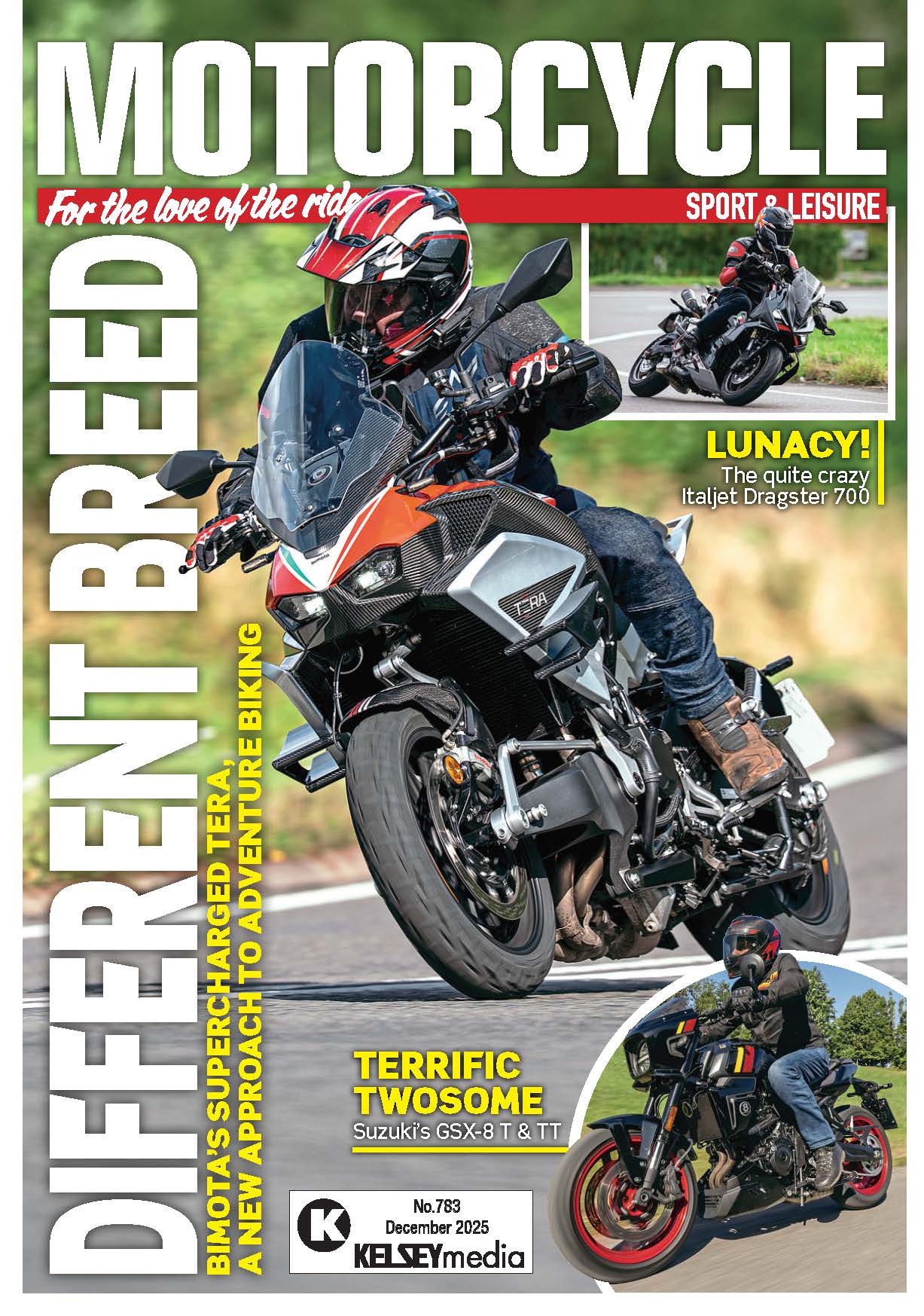A proven powerplant, some retro style hints, and a modern array of electronic rider aids make for a very nice place to spend some time.
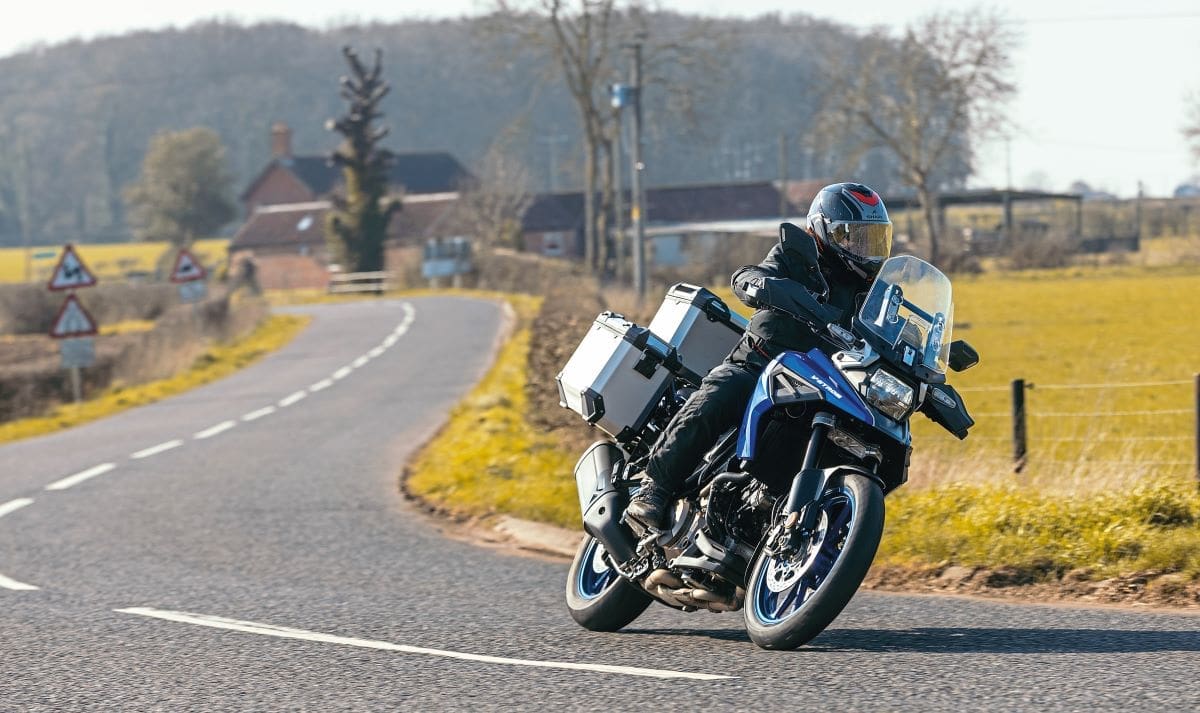
Words: Dave Manning Photography: Gary Chapman
It’s easy to assume that, with the venerable vee twin powerplant that powers the 1050 V-Strom being a little long in the tooth, the bike it powers is equally old hat and no longer up to scratch with regards to its competitors.
That would be a silly thing to assume.
Enjoy everything More Bikes by reading the MoreBikes monthly newspaper. Click here to subscribe, or Read FREE Online.
Although that 1037cc 90° vee twin is an older design, being essentially the same lump that powered the fruit-loop TL 1000S when it was launched way back in 1997, it has not just had a marginal increase in capacity. It was originally 996cc with the extra capacity coming from a 2mm increase in bore size. A slight reduction in compression ratio (down from 11.6:1 to 11.3:1) resulted in some changes in power output, and it has also benefitted from Suzuki’s technological advances that have been brought in over the last few years.
Consequently, not only does it have a flexible power delivery without the rev-hungry attitude when ensconced within the TL’s sporty chassis, it now has a ride-by-wire throttle that enables all the rider aids you’d expect from a bike built in the Twenty-twenties, as well as a six axis IMU (Inertial Measurement Unit) that enables the very latest level of spec such as lean-angle sensitive ABS etc. To think that the 1050 ‘Strom is an old bike would be wrong indeed.
Like other models from the Hamamatsu brand, the electronic suite is encompassed by the SIRS – Suzuki Intelligent Ride System – which includes further acronyms in the form of STCS (Suzuki Traction Control System), and SDMS (Suzuki Drive Mode Selector). STCS has three modes, or can be turned off, while SDMS gives three power modes, all of which deliver the same maximum power but with varying throttle response and torque characteristics.
Ride-by-wire also enables a cruise control system which works between 2,000 and 7,000rpm, but not in first (so approximately between 15 and 100mph) and has a ‘resume’ function that returns the bike to the last speed setting before it was disengaged. There’s also the two direction quickshifter, that operates up and down the box, blipping the throttle on the downchanges.
Aside from the ABS having an ability to operate at angles of lean, thanks to that Bosch 6-axis IMU, it has two modes – one being more proactive and the other having minimal intervention on the dual braking system. Yes, in order to make the most of the strong, radially-mounted Tokico four pots at the front, the V-Strom can also activate the rear brake when required without the need for you to touch the pedal. Equally, it can operate the front when you’re stamping on that very same pedal with your right foot. Clever huh? It also prevents rear wheel lift thanks to the Slope Dependent Control System. Oh look, another acronym.
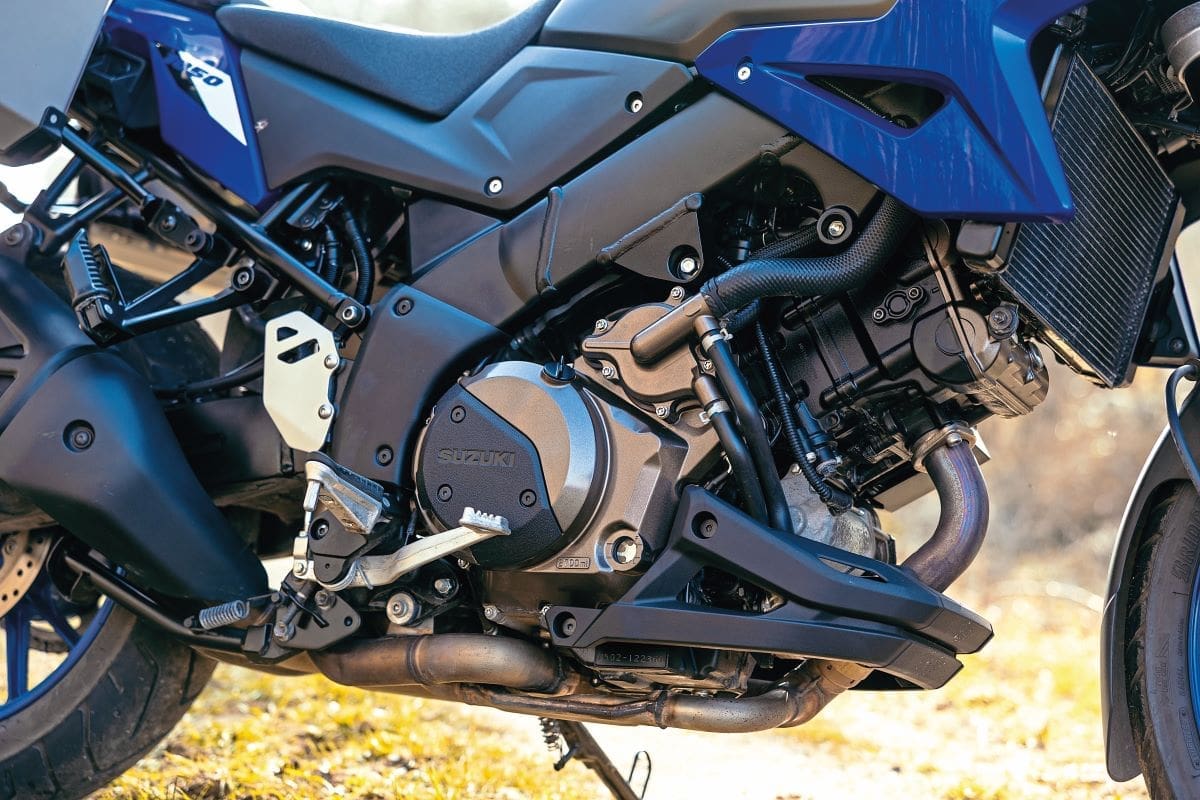
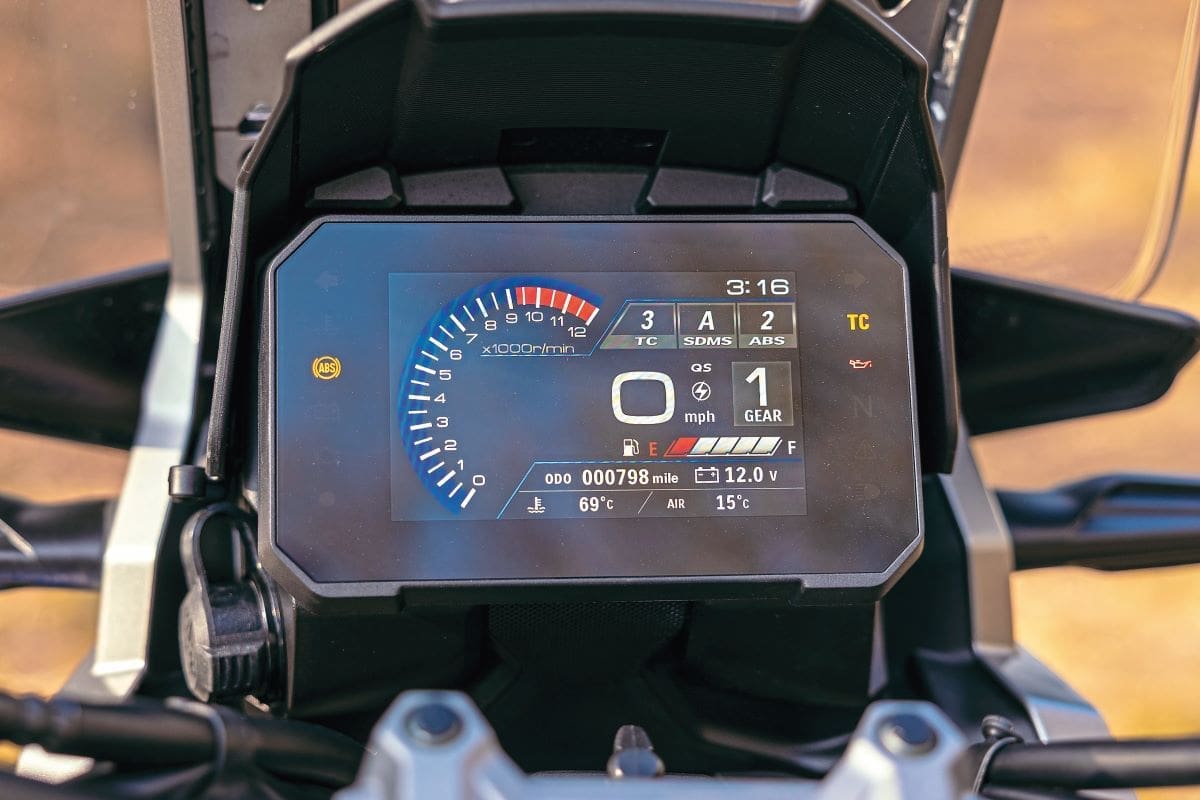
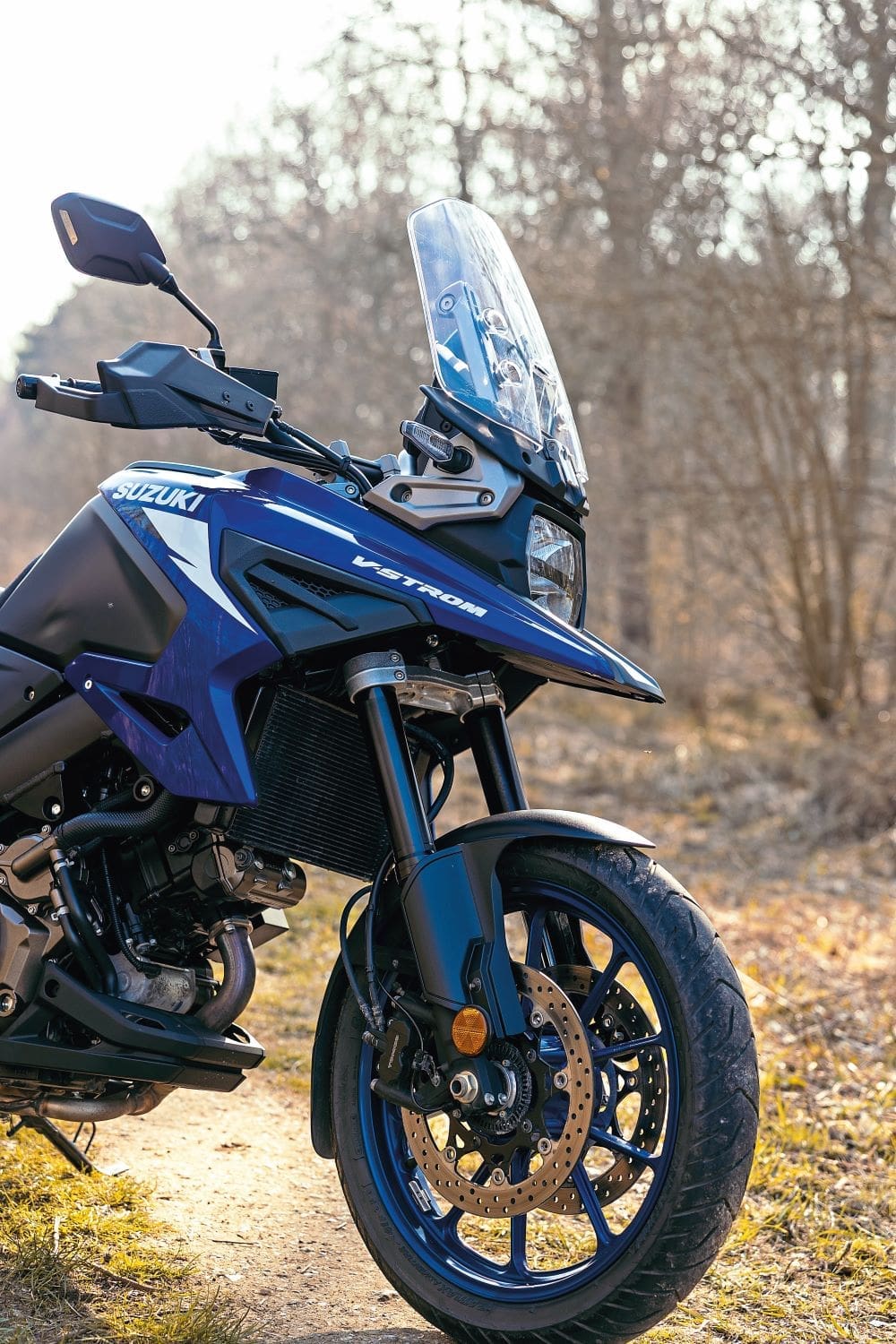
As per other models of late, there’s also Easy Start and Low RPM Assist – allowing a one press starter button, and a raise of rpm when the clutch is being released, so if you want you can ride at slow speed without touching the throttle. Additionally, there’s the Hill Hold Control System – as the name suggests, this holds the rear brake on at a standstill on an uphill slope for 30 seconds. When Suzuki first brought out the vee twin engine, not a single one of these rider aids were fitted – but then they hadn’t even been thought of at that point!
With the torque figure sitting at a very neat and orderly 100Nm, the previously sports-orientated vee twin has made the transition to dual-sport very well.
In previous iterations with the TL R and S, the vee twin had twin exhaust pipes – the V-Strom has a neater single end can, improving the packaging overall but probably as much a result of the bike needing to be fitted with a catalytic converter helping it to comply with Euro 5 emissions regs as much as making it neat and tidy.
The single can also makes it sound a little different to the sports machines, but that’s not to say it doesn’t sound nice – it sounds lovely, if a touch on the quiet side. While that may sound a little antisocial of me, in wanting to make a bike noisier, it’s perhaps as much down to the fact that the V-Strom doesn’t have much in the way of induction noise when compared to other machines as me wanting a noisy exhaust. And, reflecting on the spec of the electronics on the 1050, I’d suggest this is the only factor that actually dates the V-Strom when compared to other adventure bikes of this capacity and/or price range – it hasn’t got the modern fad of making an aurally-pleasing induction roar.
The end result is an engine that is very much suited to the chassis in terms of making a wonderful road bike – smooth, punchy and potent, and while it has had a little character removed when considering what it was like when it first appeared on the market in the TL, that vee twin now has a different feel to the mass of parallel twins that power its competition. And the one vee twin of similar style and function – the new 890cc Multistrada – seems to go out of its way to feel like a parallel twin!
The rider’s seat can be raised by 20mm using the seat raisers that are stashed beneath the pillion perch, and while this initially sounds like it’s going to be rather high (at 875mm), because of its shape it’s actually quite low on the standard setting for my 32” inside leg, and I easily get both feet fully flat at a standstill. There is also an aftermarket option that gives a seat height 30mm lower than standard. More adjustability arrives with the screen, which has a full two inches of up-and-down, albeit being yet another screen that you have to actually get off the bike to be able to adjust! Mind you, it is noticeably quieter than many other adventure bike screens, and I’m wondering if this is down to the fact it appears to be a little wider than most.
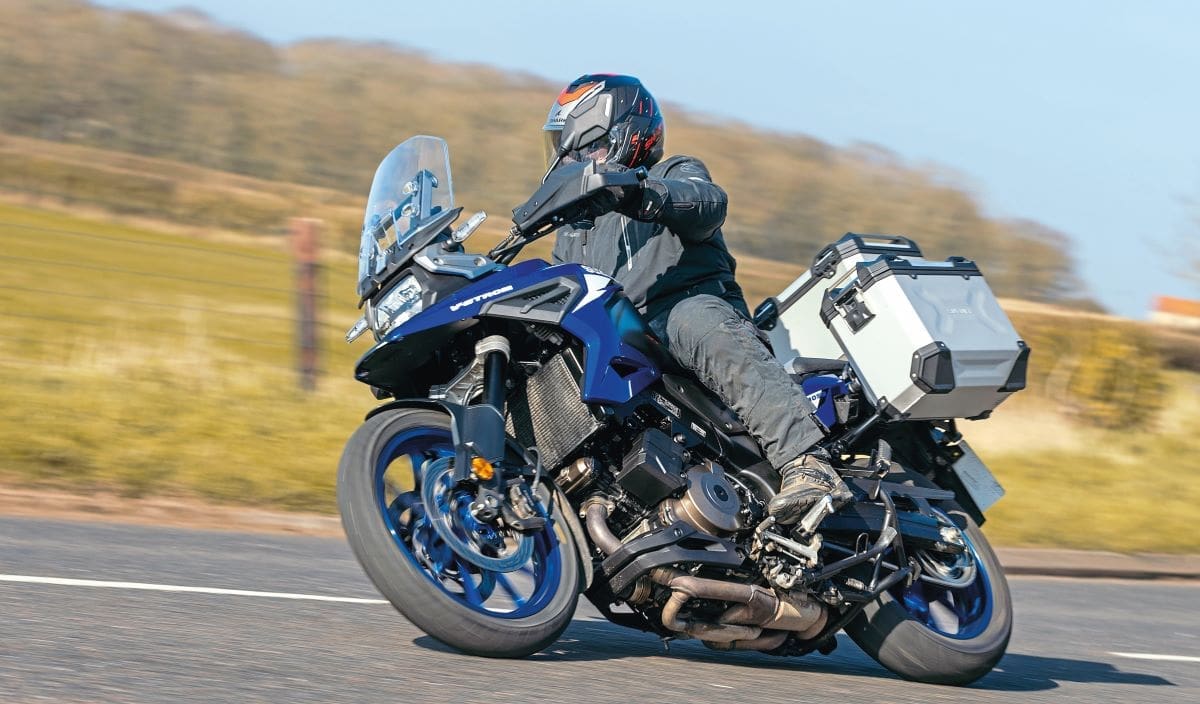
I noticed a little buffeting to the back of my helmet at quicker road speeds but it was still much quieter than other bikes of this size and style.
There’s a USB port to the left of the dash, and a further 12v power outlet under the seat, so it’s set up ready for your satnav / phone and heated clothing. Further proof the big Suzuki comes ready for long distance exploring is shown by a centre stand being standard fitment rather than an additional extra (or not existing at all).
As you may have guessed from the images, this isn’t the basic model of the 1050 V-Strom, but the Tour version, that retails at 1,500 quid more than the basic version, and is equipped with the three piece luggage, different shaped handlebars for greater long distance comfort, and rubber-covered footpegs.
There is also the DE model (of both standard and Tour versions), that is equipped in a way that perhaps offers a little more off-road ability, given its bare steel footpegs, sump guard, spoked wheels etc (the Tour version of which costs £15,499).
The luggage comprises a 38-litre top box, and panniers of 37 litres apiece and, aside from the frustrating locking mechanism (in which you can only remove the key when it is locked, even when the case lid is open), they’re great – top openers, and the top box big enough to contain a full-face helmet.
There are eight different colour options – blue, orange, red, metallic blue, two versions of grey and two versions of metallic black – and it’s perhaps the blue scheme you see here that is most reminiscent of that iconic bike that could be argued as being Suzuki’s first adventure bike, the DR750 launched in 1988.
While the V-Strom doesn’t have the colossal 29-litre tank the original DR had, the 20-litre fuel cell should give a range that’s more than 200 miles, given that Suzuki claims a very reasonable 54.2mpg. We’ll be running a 1050 as part of the 2025 test fleet so we’ll be able to verify if this figure is accurate or not. Given previous experiences with Suzukis (notably the Busa and GSX-S 1000), I’m going to predict that the real world consumption is actually going to be a little more frugal, although others in the industry have suggested the exact opposite will be the case! We’ll know more next month…
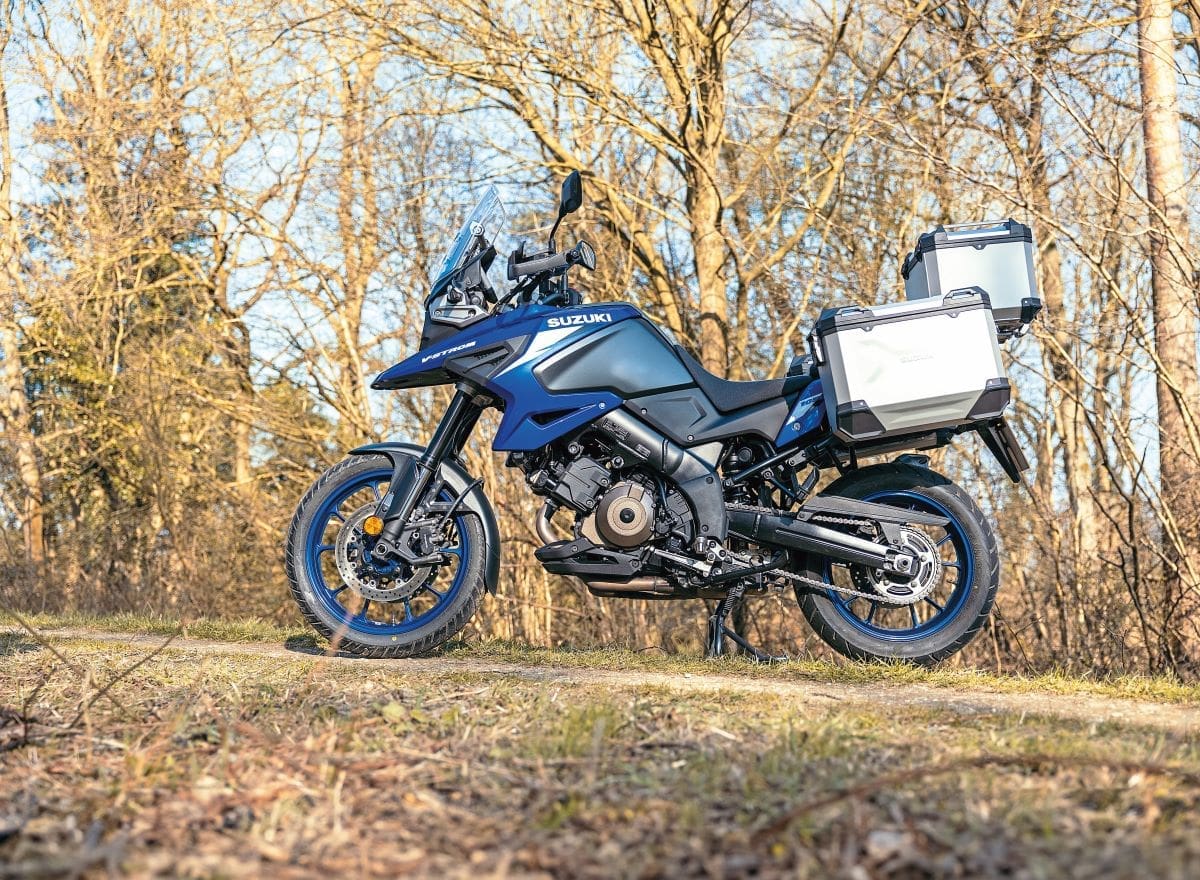
Engine – In typical Suzuki fashion, this powerplant is a long-lasting design, yet still not outdated, thanks to a capacity increase and the adoption of a ride-by-wire throttle.
Suspension – Only preload adjustable at each end but also offering 160mm of travel front and back.
Electronics – A full suite of 21st Century tech, with the inevitable multitude of confusing and mind-numbing acronyms, is enabled by the ride-by-wire throttle and a six axis IMU
Brakes – The Combined Braking System applies the rear brake when a certain level of braking is applied to the front, aiding stability and optimising braking efficiency, and this also recognises load on the bike, so alters the braking pressure to suit when you’re carrying a pillion and/or fully loaded with luggage.
Luggage – A full three box system, made from aluminium and in either black or silver, it offers 112 litres of storage in total!
Styling – Perhaps the most retro of the current glut of adventure bikes, the Suzuki clearly harks back to the iconic ‘Doctor Big’ DR750 and 800 of the late Eighties, thanks to that rectangular headlight (now fully LED) and imposing ‘duckbill’ front mudguard.
Wheels – The regular 1050 and 1050 Tour, as seen here, have cast aluminium wheels, while the DE versions have spoked wheels of larger diameter, a little more suited to off-road shenanigans.
Specification
Make and model: Suzuki V-Strom 1050 Tour
Price: £14,999 (basic V-Strom 1050 £13, 499)
Engine: 1037cc, 90° vee twin, water-cooled, DOHC, 100.0mm x 66.0mm bore/stroke
Power: 106bhp (79kW) @8,500rpm
Torque: 73.8lb-ft (100Nm) @ 6,000rpm
Frame: aluminium, with cast & extruded sections
Wheelbase: 1555mm
Rider aids: switchable lean angle ABS, traction control, 3 power modes, cruise control
Brakes: linked brakes, (F) 310mm discs, Tokico monoblock calipers, (R)
Transmission: 6 gears, chain final drive, quickshifter
Suspension: (F) 43mm inverted KYB forks, 160mm travel, fully adjustable, (R) KYB monoshock, 160mm travel, preload adjustable
Wheels/tyres: 10 spoke cast aluminium wheels, (F) 110/80×19” Bridgestone Battlax Adventure A41 (R) 150/70×17” Bridgestone Battlax Adventure A41
Seat height: 855mm
Fuel capacity: 20 litres
MPG: 54.2mpg (claimed)
Weight: 242kg
Warranty: 3 years
Contact: www.bikes.suzuki.co.uk

